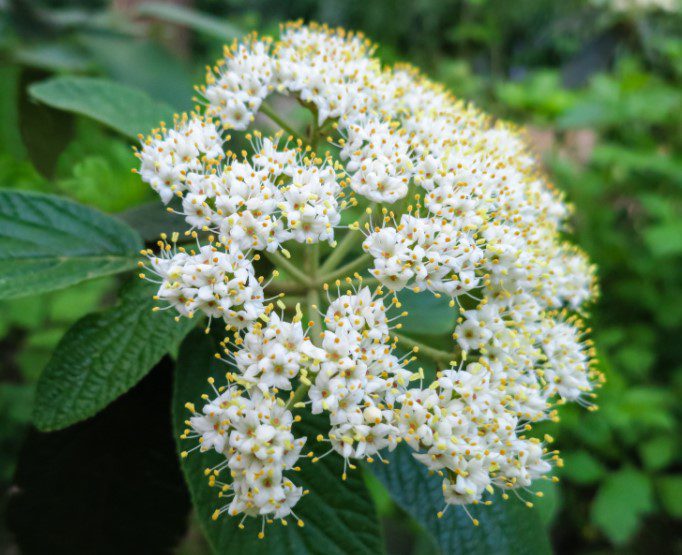Leatherleaf Viburnum
The leatherleaf viburnum is a large, fast-growing evergreen or semi-evergreen distinguished by its large, beautiful, almost oblong, or elliptical crinkled leaves that turn purple in the fall.
The purplish leaves often remain on the tree through the winter, providing seasonal interest as well as an amazing surrounding for wildlife, such as birds who also like to eat the shrub’s berries. Sometimes, however, severe cold weather causes the leaves to fall from the tree.
Leatherleaf viburnum’s large leaves display a dark green top during the spring and summer and almost felt gray undersides. Small, creamy-white flowers in flat-topped clusters bloom in the spring and sometimes appear again in the fall. In the winter, the oval fruits turn from red to black.
This handsome flowering shrub, known botanically as Viburnum x rhitidophylloides, grows quickly from 8 to 12 feet high. It is not fussy, can grow in average soil, and is drought-tolerant.
It can be seeded in the sun or shade. It is best transplanted from containers purchased at nurseries or garden centers as soon as the soil is workable. Trees dug from the field should also be transplanted in the early spring.
The leatherleaf viburnum is sometimes found at nurseries under the cultivar ‘Alleghany,’ which has elliptical, leathery, deep green puckered leaves and clusters of yellowish-white flowers, according to “The Hillier Gardener’s Guide to Trees and Shrubs.”
This shrub makes a good hedge and fits well into a wildlife garden or shrub border, especially with other shrubs that provide winter interest, such as dogwoods, hollies, and grasses.
Let’s Discuss Leatherleaf Viburnum And Other Viburnums
In the past, I have recommended many varieties of spring-flowering shrubs, but I am going to concentrate in this article on one specific genus, the viburnums. I consider these to be some of the most underutilized landscape shrubs in Utah.
While most nurseries stock a few of these plants, it is a huge group, including about 175 species of shrubs and small trees. When you add in the cultivars, you could get several times that many choices.
The viburnums’ great diversity of origins also enhances their usefulness. Although most are native to the Northern Hemisphere, there are native choices from Asia, South America, and other subtropical and tropical areas.
Few species exhibit such great variation in their size. They grow in height from 2 feet to 30 feet. Along with excellent foliage, very showy and often fragrant flowers, they have, in many cases, showy fruit and interesting winter appearance as bonuses.
Spring is the time to start enjoying these plants. Their clusters of flowers are mostly white, although there are several pink types. The flower clusters range from large, rounded snowballs to clusters that have a more flat form.
Fall is the second-most valuable ornamental season. Fruit color is usually orange, yellow or red, or dark blue or black. In addition to the colorful fruits, the fall foliage is exceptional on several types, with brilliant reds, oranges, and yellows and occasional maroons and purples adding interest.
The leaves also add great interest. Summer foliage is often glossy, with numerous variations, including velvety leaf surfaces, bold rough-veined textured leaves, or rough, leathery leaves that remain evergreen during mild winters.
These are a few of the viburnums that do well in Utah landscapes:
Pink dawn viburnum (V. x bodnantense) is a large deciduous shrub that grows to 10 feet. It has deeply veined leaves with early, fragrant pink flowers. I noticed this one in bloom several weeks ago. The fruit is dark blue, and it is hardy to Zone 6.
Burkwood viburnum (V. x burkwoodii) is another local favorite. The dark leaves have a silver underside, and the plant is open-branched and reaches 6 feet in height and spread. It tolerates sun or partial shade and has red fall color. The white flower clusters are fragrant but sterile, so they bear no fruit. It also is hardy to Zone 6.
As its name implies, fragrant snowball (V. x carlcephalum) has a wonderful, perfumed scent. The long-lasting white flowers produce no fruit, and the dull gray-green leaves are fuzzy underneath. The 8- to 10-foot tall shrub grows 4 feet to 5 feet across and is hardy to Zone 2.
Korean Spice Viburnum (V. x carlesii) grows 4 feet to 8 feet tall with a 4- to 5-foot spread. The dull green leaves are fuzzy underneath. The flower buds are pink and open to white and are fragrant. This plant has blue-black fruit and is hardy to Zone 2.
Dwarf European cranberry bush (V. x opulus nanum) is a smaller plant that only grows 2 feet high and 2 feet wide and is good for low hedge or foundation planting. It has a red fall color and rarely flowers or fruits and is hardy to Zone 4.
Common snowball (V. x opulus roseum) is the viburnum with which most gardeners are familiar. It grows 12 feet or more in height and prefers full sun. It has stunning clusters of greenish flowers that turn white. It seldom fruits and is hardy to Zone 3.
Leatherleaf viburnum (V. x rhytiodophyllum) is large, narrow, upright, mostly evergreen, and grows to 15 feet in height. The long, green leaves are crinkled and fuzzy beneath, and the flower clusters are off-white. It is hardy to Zone 4, and the small fruits are scarlet.
American cranberry bush (V. x trilobum) grows 10 feet high with an 8-foot spread. The lobed green leaves turn red in fall, and it has white flowers in May. The scarlet berries are edible, and it is hardy to Zone 2.
In addition to their beauty, viburnums are resistant to most pests except aphids and adapt to many soil and environmental conditions.
Pruning is minimal, and if you choose the right varieties for your landscape, they will be beautiful additions.


























